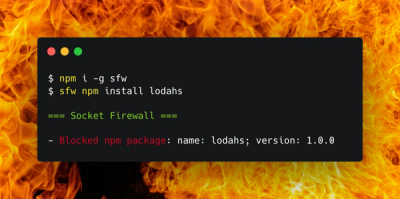
Product
Introducing Socket Firewall: Free, Proactive Protection for Your Software Supply Chain
Socket Firewall is a free tool that blocks malicious packages at install time, giving developers proactive protection against rising supply chain attacks.
bastascript
Advanced tools
Bastascript is a language designed to improve JavaScript's ability to serve as a functional programming language with terse, obvious syntax. Bastascript is a subset of JavaScript extended with additional syntax that compiles to JavaScript.
You can compile a BS file with the following command:
bs file_to_compile.bs
The generated code will be piped to stdout.
Adding the --run flag will execute the code after compiling.
Bastascript makes heavy use of partial functions, which are applied in a manner
more similar to currying. This is accomplished via the skinny arrow operator
(->).
Some examples:
promise.then(function() {
foo.bar(x);
}, function(err) {
console.error(err);
});
could be written as
promise.then(foo.bar->(x), console.error->());
A skinny arrow augmented assignment operator is provided:
x = x->(1, 2, 3);
// equivalent to
x =->(1, 2, 3);
Currying can be simulated like this:
function myfunc(x, y, z) {...;}
var curr = myfunc->();
curr =->(1);
curr = curr->(2);
console.log(curr(3));
Creating a partial function preserves the context of members. For instance:
var x = foo.bar.bind(foo);
// equivalent to
var x = foo.bar->();
x = x.y can be written as x .= y.
...; will throw a new error named "Not Implemented".
if (someCondition) {
...;
}
for (var i in foo) {
if (foo.hasOwnProperty(i)) {
console.log(i);
}
}
can be written as
for (var i in foo if foo.hasOwnProperty(i)) {
console.log(i);
}
foo.method = function method() {};
can be written as
function foo.method() {
...;
}
Note that the method name is preserved.
var myFunc = decorator(function() {
// ...
});
obj.method = decorator(function method() {});
can be written as
@decorator:
function myFunc() {
...;
}
@decorator:
function obj.method() {
...;
}
Decorators can be members or call expressions:
@ident:
@dec.method:
@call(foo, bar):
@dec.call(foo, bar):
Decorators can be chained, and will be applied such that the outermost decorator will be applied last.
later StatementThe later statement allows you to defer a statement's execution until after
the completion of the remainder of the function.
function test(shouldMock) {
if (shouldMock) {
mock();
later cleanup();
}
...;
}
later statements retain lexical scope and their access to the this
identifier. later statements will not presently work with generators.
If an exception is thrown in a function with later statements, none of the
deferred statements will be executed. You should catch exceptions with try
blocks instead.
Return statements support a ruby-like unless clause that expands out to an
if (!expr) construct. They may also use if, which expands out to
if (expr).
return foo unless bar;
return foo if bar;
vs.
if (!bar) {
return foo;
}
if (bar) {
return foo;
}
The function keyword can be replaced with the unicode character ƒ. This
also works with generators: ƒ*.
ƒ foo() {
...;
}
function foo() {
// ...;
}
Fat arrow functions should work as they're documented in the Harmony wiki.
x = () => foo;
y = elements.map(e => e.getAttribute('name'));
vs.
x = function() {return foo;};
y = elements.map(function(e) {return e.getAttribute('name')});
Arrow functions will bind this lexically (as in ES6) when this is used.
Note that later statements are not bound to arrow functions and instead are
bound to the lexical parent. If the arrow function executes after the lexical
parent has completed, the later statement will not be run.
with statement.v0.2.0
Fixes:
.bind(this) is only applied to generated code where a ThisExpression is
present.FAQs
A JavaScript dialect that adds some useful crap.
The npm package bastascript receives a total of 0 weekly downloads. As such, bastascript popularity was classified as not popular.
We found that bastascript demonstrated a not healthy version release cadence and project activity because the last version was released a year ago. It has 1 open source maintainer collaborating on the project.
Did you know?

Socket for GitHub automatically highlights issues in each pull request and monitors the health of all your open source dependencies. Discover the contents of your packages and block harmful activity before you install or update your dependencies.

Product
Socket Firewall is a free tool that blocks malicious packages at install time, giving developers proactive protection against rising supply chain attacks.

Research
Socket uncovers malicious Rust crates impersonating fast_log to steal Solana and Ethereum wallet keys from source code.

Research
A malicious package uses a QR code as steganography in an innovative technique.